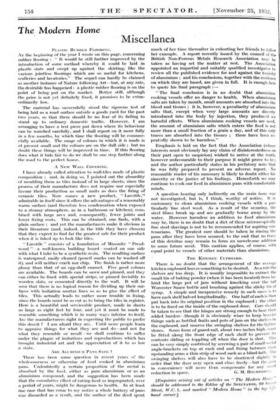A NEW WALL COVERING.
I have already called attention to wall-tiles made of plastic 'composition ; and, in doing so, I pointed out the absurdity of moulding them as tiles instead of in large sheets, since the process of their manufacture does not require nor especially favour their production as small units as does the firing of ceramic tiles. Now comes a new product, " Lacotile," admirable in itself since it offers the advantages of a reasonably warm surface (and therefore less condensation when exposed to a steamy atmosphere, as in a bathroom or kitchen), com- bined with large area and, consequently, fewer joints and lower fixing Costs. This can be obtained, one finds, with a plain surface ; and yet the manufacturers make it obvious in their literature (and, indeed, in the title they have chosen) that they expect to find far the greatest sate for their product when it is faked up to look like tiles.
" Lacotile " consists of a foundation of Masonite " Presd- wood ":---a well-known building board—coated on one side with what I take to be a synthetic resin. The resulting surface is waterproof, easily cleaned (pencil marks can be washed off it), and will neither crack nor chip. The finish is rather more glossy than that of an egg-shell enamel. Five good colours are available. The boards can be sawn and pinned, and they can either be fixed with special strips, or pinned invisibly to ivooden slats, or cemented directly to the wall. It will be seen that there is no logical reason for dividing up their sur- faces with imitation mortar lines so as to give the effect of tiles: This actually leads to rather more trouble in fixing, since the boards must be so cut as to bring the tiles in register. Here is a beautiful and serviceable product, made in sheets as large as eight feet by four, and yet it must be made to resemble something which is in many ways inferior to itself. Are the manufacturers right in expecting the public to prefer this 'deceit ? I am afraid they are. Until more people learn to appraise things for what they are and do—and not for what they resemble or recall—we shall continue to suffer under the plague of imitations and reproductions which has brought industrial art and the appreciation of it to so low a state.






































 Previous page
Previous page